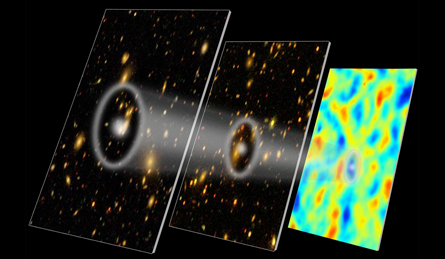- More than 2 years ago
ATLANTA — Einstein is still the boss, say researchers with the BOSS project for measuring key properties of the universe.

BOSS, for Baryon Oscillation Spectroscopic Survey, has measured the distance to faraway galaxies more precisely than ever before, mapping the universe as it existed roughly 6 billion years ago, when it was only 63 percent of its current size. The findings suggest that the mysterious “dark energy” causing the universe to expand at an accelerating rate was foreseen by Einstein, the researchers reported April 1 at the American Physical Society meeting.
To keep the universe in a static state, Einstein added a term called the “cosmological constant” to the equations for his theory of general relativity; when the universe was later found to be expanding, he called the constant his “biggest blunder.” But in recent years, the cosmological constant, which describes a repulsive force occupying all of space, has been invoked to explain the discovery, first reported in 1998, that the universe is expanding faster and faster.
Evidence for accelerated expansion could be explained either by the negative pressure exerted by the cosmological constant (or some other form of dark energy) or by some flaw in general relativity. The BOSS results support the dark energy picture. “We find no deviations from general relativity on these very large scales,” said Nikhil Padmanabhan, a physicist at Yale University who presented the results and is a coauthor on a series of papers posted online at arxiv.org.
BOSS, a part of the third Sloan Digital Sky Survey, will operate through 2014. Its current results are for about a quarter million galaxies. The key to the measurements are an imprint of sound waves — called baryon acoustic oscillations — frozen into the radiation from 300,000 years after the Big Bang, which occurred 13.7 billion years ago. These sound waves caused regularly spaced bumps in the distribution of galaxies throughout the cosmos, and so can serve as a sort of space ruler.
This ruler has allowed the researchers to measure the distance back to an epoch when the universe was 63 percent its current size, at 2,094 million parsecs plus or minus 34 million parsecs, a precision of 1.7 percent. (A parsec equals about 3.26 light-years.) The previous best measurement, also from the Sloan survey, looked back not quite as far, to when the universe was 75 percent its current size, with 2 percent precision.
The findings from this improved measurement are consistent with dark energy described by Einstein’s cosmological constant.
“At this stage, we are all trying to fire bullets at the cosmological constant,” says Adam Riess of Johns Hopkins University, who shared the Nobel Prize in physics last year for the discovery of the universe’s accelerated expansion. “It is a pretty sharp bullet when you are making measurements that are more precise than ever before.”
Riess says that within the next few years, combining data from baryon acoustic oscillations, as well as other ways of probing the universe’s expansion rate over time, should increase the precision of the dark energy measurements by a factor of 100. If these results support general relativity, they still won’t prove that the theory is correct. But they would be hard to argue with.
“I think most people will say uncle after this factor 100 improvement,” Riess says.







